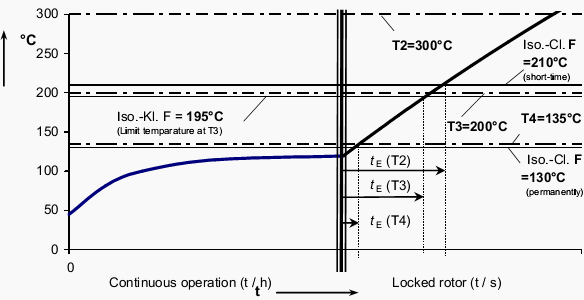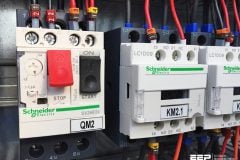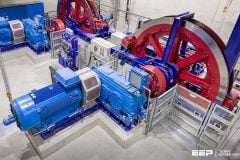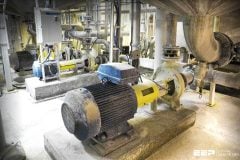Hazardous Areas
Electrical drives/motors that are operated in hazardous areas must be built and engineered so that they cannot become an ignition source. This applies not only to normal operating and starting, but also in case of faults, for example at stalled rotor.

The specified temperature limits for hot surfaces as a potential source of ignition have for ignition protection types:
- Flameproof enclosures “d” (Transfer of an explosion to the outside excluded) and
- Pressurized enclosures “p” (Ex-atmosphere is kept away from the source of ignition)
to be complied with only on the outside of the enclosure.
Due to the lag in temperature changes of the motor housing, short-term temperature rise of the windings over the limit temperature of the temperature class are with these ignition protection types regarded as non-critical from an explosion protection viewpoint.
In contrast, with a motor of ignition protection type Increased Safety “e” (suppression of sparks and high temperatures), exceeding the limit temperature of the corresponding temperature class, for which the motor is foreseen, inside the motor even short-term is not permissible.
Table 1 – Limit temperatures of electrical machines of ignition protection type “e” with insulation material class F.
| Limit temperatures (°C) | |||||||
| Temperature class | T1 | T2 | T3 | T4 | T5 | T6 | |
| Ignition class IEC/EN 60079-14, Tab.1 | > | 450 | 300 | 200 | 135 | 100 | 85 |
| Maximum surface temperature EN 50014. Tab.1; IEC/EN 60079-14 Tab.1 | ≤ | 450 | 300 | 200 | 135 | 100 | 85 |
| Windings class F continuously EEx e, EN 50019, Tab. 3 | ≤ | 130 | 130 | 130 | 130 | 95 | 80 |
| Winding class F at end of tE EN 50019, Tab. 3 | ≤ | 210 | 210 | 195 | 130 | 95 | 80 |
NOT COLORED = determined by the temperature class of the gas
COLORED = determined by the temperature class (isolation class) of the windings
In theory this signifies a doubling of the windings life span and serves to increase safety, also resulting however in a reduction of the power output compared with the standard values for a motor of the same size.
The permissible limit temperature of a winding in an electrical machine of ignition protection type Increased Safety “e” depends, on the one hand, on the temperature class from the explosion protection viewpoint and, on the other, on the insulation material class of the winding.
Table 2 shows the relevant limit values for motors of isolation class F.
If another insulation material is used, these values change according to the temperature class of the insulation material (Table 2).
Table 2 – Limit temperatures of motors of ignition protection type “e” and “d” in relation to the insulation material class of the windings
| Limit temperatures (°C) | ||||
| Insulation class | E | B | F | H |
| „d“, Continuous service | 115 | 120 | 145 | 165 |
| „e“, Continuous service | 105 | 110 | 130 | 155 |
| „e“, at the end of the tE-time | 175 | 185 | 210 | 235 |
With respect to the temperature rise characteristics of an electrical machine, two operating statuses should be taken into account: continuous duty and stalled rotor motor.
At continuous duty under full load the machine slowly heats up and after several hours, depending on its size, reaches its steady-state temperature. At the highest permissible ambient temperature, this steady-state temperature may not exceed the limit temperature of the insulation material class nor of the temperature class.
In the schematically presented example of the heating characteristics of a machine of insulation material class F in Figure 1, neither the permitted limit of temperature class T4 nor that of insulation material class F are exceeded once the steady-state temperature has been reached. The second operating case should be considered as more critical. It occurs if the rotor of the 3-phase asynchronous motor becomes stalled after running at service temperature.
The current that then flows is several times higher than the rated current and causes the temperature of the rotor and stator windings to rise rapidly.
A monitoring device must disconnect the machine from the supply within the heating time tE, i.e. the time for the limit temperature of the windings to be reached. The heating time tE is the time after which the permissible temperature is reached with a stalled rotor condition starting from service temperature. It is a characteristic quantity of the motor.

As the selected example of a motor with stalled rotor in Figure 1 shows, the limit temperatures of the temperature class for applications T4 and T3 determine the tE-time.

If however the machine is intended for hazardous areas of temperature class T2 (or T 1), the thermal limit is determined by the short-term permissible limit temperature of isolation material class F of 210 °C.
With explosion protection type Increased Safety “e” this particularly requires connection to a correctly selected and adjusted overload protective device.
Resource: Allen Bradley – Low Voltage Switchgear and Controlgear











Useful information but wording is very poor. It seem like a direct translation from another language.
very useful information